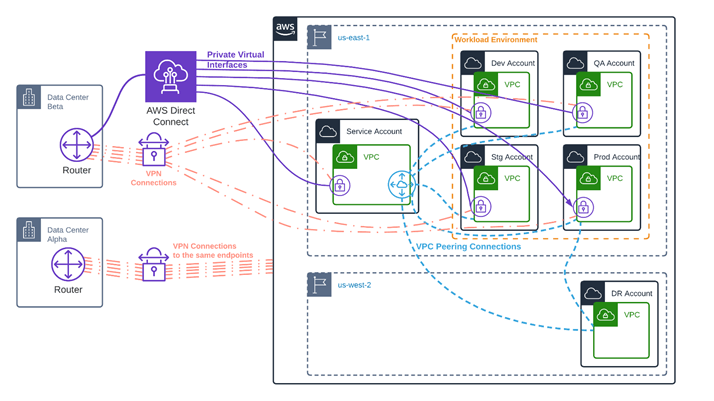Infrastructure Optimization With AWS Transit Gateway Leads to 90% Reduction in Networking Costs
Nov 5, 2020


When a client came to us needing to consolidate its data centers, there was a great opportunity to modernize the network and significantly reduce the customer’s networking costs. With Amazon Web Services (AWS), ClearScale was not only able to meet the customer’s goals but do so ahead of schedule.
Our client had a significant online presence consisting of numerous Amazon Web Services (AWS) environments. The company also had a large set of on-premises environments deployed in several offices and datacenters around the United States.
All the on-premises sites were connected to each other using various types of virtual private networks (VPNs) and fiber channels. On the AWS side, the workload accounts were connected to the on-premises network. Also, they could talk to a shared AWS account containing Active Directory and DNS services. Flawless high-speed internet connectivity for all parts of the IT ecosystem was a vital requirement for this client.
The Challenge
The client had started the process of consolidating two on-premises data centers, Alpha and Beta, and was migrating resources from datacenter Beta to datacenter Alpha. An important factor in the Beta-based setup was AWS Direct Connect link, connecting the client’s on-premises network with its AWS infrastructure. The company wanted to establish a new Direct Connect link from the Alpha location, and use that change as an opportunity to pursue the following goals:
- Modernize the networking design by leveraging up-to-date AWS managed services
- Simplify future ongoing management and add new environments to the AWS infrastructure
- Optimize networking costs on AWS, while retaining high availability and sufficient bandwidth
Time was of the essence. The client had a hard deadline on migrating off the Beta datacenter due to expiring contracts with the Beta datacenter, as well as with the Internet Service Provider responsible for DX fiber connection from Beta to AWS.
The Solution – AWS Transit Gateway
ClearScale engineers conducted a thorough examination of the client’s AWS assets. The analysis revealed five different workload environments, with four AWS accounts in each environment, plus an AWS account containing shared services such as Active Directory, and a Disaster Recovery account in another region. This came out to 22 different AWS accounts in total.
Each workload account contained a virtual private cloud (VPC) connected to the on-premises network through a Direct Connect virtual interface. There were also two redundant VPN tunnels to each datacenter for backup purposes in case of a Direct Connect failure. Also, each VPC had a peering connection to the VPC in the shared account.
This legacy setup was overcomplicated, redundant, and expensive. Especially considering that the Direct Connect link was an underutilized 10 Gbps fiber link.
Figure 1: Initial State


AWS Transit Gateway
After discussions with the client’s networking team and AWS representatives, ClearScale came up with a solution that leveraged AWS Transit Gateway as a central hub, serving as a junction router for all the workload VPCs, and terminating the Direct Connect and backup VPN connections. As a result, the virtual interfaces and per-VPC VPN connections were deemed unnecessary and queued for termination.
Transit Gateway acts as a regional virtual router for traffic flowing between VPC and VPN connections. It scales elastically based on the volume of network traffic. Routing through a transit gateway operates at layer 3, where the packets are sent to a specific next-hop attachment, based on the destination IP addresses.
A Direct Connect link capacity of 1Gbps was deemed to be sufficient for the client’s current and foreseeable needs.
Figure2: Updated Networking Architecture


As part of the preparation, the Terraform templates describing the configuration of each environment – including routing tables, security groups, and network Access Control Lists (ACLs) – were updated. But the ultimate requirement was to reduce downtime to a bare minimum, limited to the duration of scheduled maintenance windows. Therefore, each environment required careful planning and close coordination between ClearScale and the client’s network engineering and application owner teams.
The client’s environments were switched over to the new networking scheme one at a time. This required multiple work sessions and thorough testing.
Business Benefits
As a result of the data center consolidation, the client achieved all of its goals and gained the following benefits:
- Costs for networking services were reduced by nearly 90% when extra VPN links and some other AWS resources became unnecessary with the new Transit Gateway solution
- Routing and the firewall configuration became more straightforward and error-proof due to the removal of a large number of redundant links
- Management of the networking infrastructure was simplified, including the creation of new workload environments
- Service disruptions and slowdown of the company’s internal application development schedules were avoided by meeting the project deadline ahead of time
Ready to see what ClearScale can do for you? Start a conversation today.
Get in touch today to speak with an AWS cloud expert and discuss how we can help:
Call us at 1-800-591-0442
Send us an email at sales@clearscale.com
Fill out a Contact Form
Read our Customer Case Studies